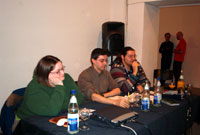|
Hacktivism: Was tun/Che fare?

Panel: Hacktivism: Was tun/Che fare? -8th February 2005, Kunstraum Kreuzberg/Bethanien, Berlin, D
[Panel's Photos]
Italy is a country between extreme differences. On the one side, the autocratic rule of Berlusconi manipulates both Italian and European politics and controls Italian mass media almost completely. On the other, there are many intellectuals and activists speaking up against this government.
The demonstrations of Genua in 2001, with millions of people protesting against the war in Iraq, and several subsequent general strikes are only the tip of the iceberg. While the institutionalised politics of Italy appear to be a rigid system, in the past ten years an active, very heterogeneous and internationally connected network of countercultures has developed. It has organised interventions and demonstrations and is reknown for its vast variety of media initiatives. The initiatives making up this network use various means of spreading their ideas: radio, net streaming of videos, mailing lists, local TV stations, websites. Often does the content not only deal with political issues, but is also concerned with subjects relevant to net and new media culture, such as the question of copyright and free networks.
The panel 'Hacktivism: Was tun/Che fare?' connects theoreticians and artists from Italy and Germany, and reflects the concept of hacktivism and its future after twenty years of independent activities in this field. Which is the status of hacktivism today? Which similarities and differences exist between the Italian concept of hacktivism and the international understanding of the term? In a time after early net cultural utopias, with the net space being dominated by economic giants and commercial interests, is hacktivism still possible? Is it still feasible to create radical independent information and artistic expression on the net? Do net communities still exist as platforms of non-hierarchical relationships?
Hacktivism: Was tun/Che fare? - 8th february 2005, 7.00 pm
- First section (7.00 pm):
- Sebastian Lütgert, Textz.com www.textz.com (Berlin, D)
- Tommaso Tozzi, Hacker Art www.hackerart.org (Florence, IT);
- Second section (8.00 pm):
- Susanne Schmidt, www.informationsfreiheiten.de (Berlin, D)
- Asbesto, Freaknet Medialab, www.freaknet.org (Catania, IT)
- public discussion (9.00 pm)
- Moderator: Alessandro Ludovico, Neural www.neural.it (Bari, IT)
[Panel's Photos]
Sebastian Lütgert – Textz.com – Bootlab (Berlin, D)
Lives in Berlin, working as a writer, programmer and artist. Recent projects include magazines (The German Issue, Starship, Auseinander), websites (germany.kz, textz.com, rolux.org), videos (Burn Hollywood Burn, Betacity, The Coils of the Serpent) and others. Group exhibitions (selection): Werkleitz Biennale (Halle), Kuenstlerhaus (Wien), Galerija VN (Zagreb), Transmediale (Berlin), Kunsthalle Exnergasse (Wien), Kunstwerke (Berlin), Cinematexas (Austin), PS1 (New York), ZKM (Karlsruhe). He is a co-founder of Bootlab (Berlin).
www.textz.com - www.bootlab.org
Tommaso Tozzi – hacker art (Florence, Italy)
Tommaso Tozzi (1960) is probably one of the first Italian artists who worked since early Nineties only on new media and the net. Rather than building installations or objects, the artist exploits new media as instruments of communication, creating spaces for discussion and meeting places. Before getting wired, Tozzi had developed a magazine transmitted by fax, an artzine only readable through BBS and an art magazine that was posted on walls. He was co-founder of the artistic group Strano Network in 1993 (Florence) and works as a Professor in the Department of Mass Media in Accademia di Belle Arti of Carrara. He was the founder of Hacker Art BBS (1990), the first artistic network in Italy and creator of the first Netstrike in the world (1995). Publications: Hacktivism. La libertà nelle maglie della rete, ManifestoLibri, 2002; with Strano Network: Nubi all'orizzonte (1996), Net Strike, no copyright, etc.- Pratiche antagoniste nell'era telematica (1996). He also work with the collective Isole Nella Rete.
www.hackerart.org - www.strano.net/tozzi.htm
Susanne Schmidt – Informationsfreiheiten.de (Berlin, D)
Susanne Schmidt studied political science in Berlin and changed suddenly her profession from science to technology in 1993, fascinated by the upcoming possibilities of the Internet and Linux. Since 1993 she works as a freelancing journalist, projectmanager and sometimes as
a software developer exclusively in Linux/Open Source environments. Main interests are natural language processing, freedom of information, possiblities of translating techniques of investigative journalism into technology and transporting technology into political activism, the development of Perl 6, women and hacking and modern japanese art.
www.informationsfreiheiten.de
Gabriele 'Asbesto' Zaverio – Freaknet Medialab (Catania, Italy)
On the net since early 80s, he is co-founder of Freaknet Medialab, freaknet.org and Radio Cybernet. Freaknet Medialab is an Italian hacklab which provides access for everybody through old assembled computers. Freaknet is lead by a committee of hackers sharing their researches in solidarity to achieve common goals: for the knowledge, for the freedom of speech, for an aesthetic vocation, for a sustainable model in free software development, for a better sharing of free technologies and informations among who has less opportunities to access them.
www.freaknet.org - http://poetry.freaknet.org - Personal website: www.zaverio.net
www.hackmeeting.org (Italian hackers community website)
Moderation: Alessandro Ludovico – Neural magazine (Bari, Italy)
Since 1993 Alessandro Ludovico is the editor-in-chief of Neural, the Italian new media culture magazine. In 2000 he edited ‘Suoni Futuri Digitali’ (Future Digital Sounds), an in-depth research that chronicles the history of the innovations that have drastically changed how we produce and experience sounds. He’s one of the founding members of the Nettime list, and one of the founding member of the ‘European Peripheral Magazine list’. In 2001 he joined the n.a.m.e. (normal audio media environment) art group and developed ‘Sonic Genoma’, a computer art installation. He's also in charge of "Neural Station", a weekly radio show on electronic music and digital culture, and is the publisher of daily updates on the Neural website.
www.neural.it
Hack.it.art info
Back to AHA Home
|





